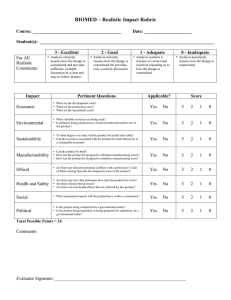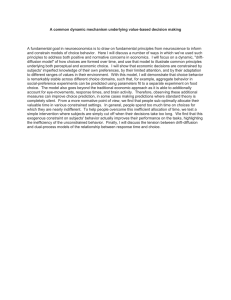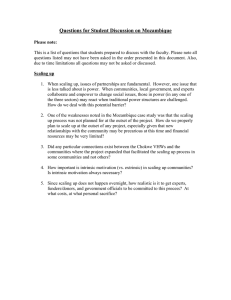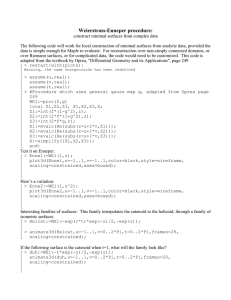Anomalous scaling in a kinetically constrained model in 1+1 dimensions Mod´
advertisement
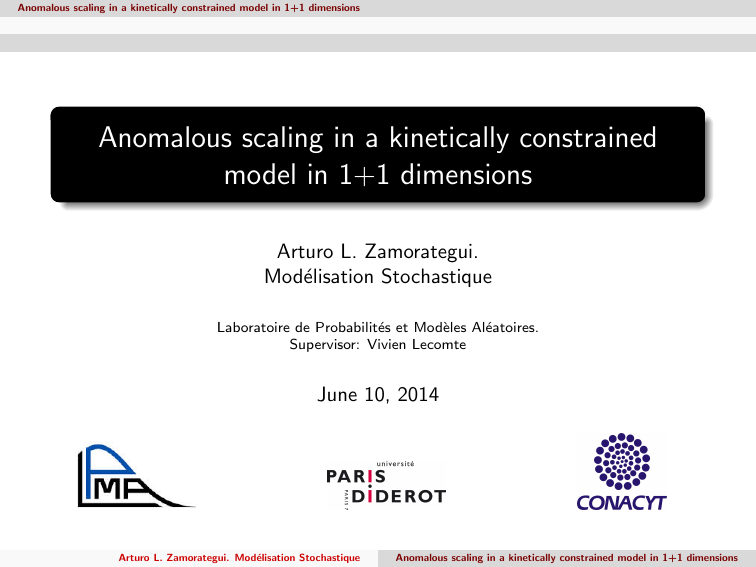
Anomalous scaling in a kinetically constrained model in 1+1 dimensions
Anomalous scaling in a kinetically constrained
model in 1+1 dimensions
Arturo L. Zamorategui.
Modélisation Stochastique
Laboratoire de Probabilités et Modèles Aléatoires.
Supervisor: Vivien Lecomte
June 10, 2014
Arturo L. Zamorategui. Modélisation Stochastique
Anomalous scaling in a kinetically constrained model in 1+1 dimensions
Anomalous scaling in a kinetically constrained model in 1+1 dimensions
Outline
1
Introduction
2
3
Part 1. Statistics
Results
4
Part 2. Towards an effective model
5
Partial Results
6
Perspectives
Arturo L. Zamorategui. Modélisation Stochastique
Anomalous scaling in a kinetically constrained model in 1+1 dimensions
Anomalous scaling in a kinetically constrained model in 1+1 dimensions
Goals
1
Understand the phase coexistence of active-inactive regions at the
point where the dynamical phase transition observed in glassy
systems occurs. Very well captured by KCMs.
2
Determine an effective model of the dynamics in the phase transition
from the simplest possible model. Is there something simpler that a
KCM ?
Arturo L. Zamorategui. Modélisation Stochastique
Anomalous scaling in a kinetically constrained model in 1+1 dimensions
Anomalous scaling in a kinetically constrained model in 1+1 dimensions
Introduction
A glass looks like...
2D binary mixture of hard disks with
different radius (Keys et al Phys. Rev.
X 1, 021013, 2011).
Start movie
Inactive particles vs Active particles
Dynamic heterogeneity: inactive regions with slow dynamics and active
regions with fast dynamics.
Facilitated dynamics: mobility in a region leads to motion of
neighbouring particles. An adjacent excitation is required for both the
birth or death of an excitation.
Arturo L. Zamorategui. Modélisation Stochastique
Anomalous scaling in a kinetically constrained model in 1+1 dimensions
Anomalous scaling in a kinetically constrained model in 1+1 dimensions
Introduction
Activity vs Inactivity
Inactive regions surrounded by active particles.
The persistent time (tp ): time a particle remains inactive before the first
move.
The exchange time (tx ): time between two consecutive moves. (Jung et
al 2004).
Dynamic heterogeneity
Facilitation
Stokes-Einstein relations:
Dη/T = constant
Not a glass
htp i = htx i = τ
-
A glass
htx i htp i
Particles close to excitation lines diffuse more quickly
Satisfied
Broken,
since τα ≈ htp i
and D ≈ δx2 /htx i:
(Dτα ≈ δx2 htp i/htx i)
Dτα = constant
τα (relaxation time)
D (diffusion coefficient)
Arturo L. Zamorategui. Modélisation Stochastique
Anomalous scaling in a kinetically constrained model in 1+1 dimensions
Anomalous scaling in a kinetically constrained model in 1+1 dimensions
A KCM
A Kinetically constrained model (KCM)
Dynamic heterogeneity (bubbles of inactivity) and facilitation (excitation lines)
are captured by kinetically constrained models (KCMs).
One spatial dimension (discrete) + one temporal dimension (continuous)
Arturo L. Zamorategui. Modélisation Stochastique
Anomalous scaling in a kinetically constrained model in 1+1 dimensions
Anomalous scaling in a kinetically constrained model in 1+1 dimensions
A KCM
A Kinetically constrained model (KCM)
Dynamic heterogeneity (bubbles of inactivity) and facilitation (excitation lines)
are captured by kinetically constrained models (KCMs).
One spatial dimension (discrete) + one temporal dimension (continuous)
It is a coarse-grained model with ni = 1 if active and ni = 0 if inactive.
Arturo L. Zamorategui. Modélisation Stochastique
Anomalous scaling in a kinetically constrained model in 1+1 dimensions
Anomalous scaling in a kinetically constrained model in 1+1 dimensions
A KCM
A Kinetically constrained model (KCM)
Dynamic heterogeneity (bubbles of inactivity) and facilitation (excitation lines)
are captured by kinetically constrained models (KCMs).
One spatial dimension (discrete) + one temporal dimension (continuous)
It is a coarse-grained model with ni = 1 if active and ni = 0 if inactive.
Arturo L. Zamorategui. Modélisation Stochastique
Anomalous scaling in a kinetically constrained model in 1+1 dimensions
Anomalous scaling in a kinetically constrained model in 1+1 dimensions
A KCM
A Kinetically constrained model (KCM)
Dynamic heterogeneity (bubbles of inactivity) and facilitation (excitation lines)
are captured by kinetically constrained models (KCMs).
One spatial dimension (discrete) + one temporal dimension (continuous)
It is a coarse-grained model with ni = 1 if active and ni = 0 if inactive.
Dynamic is controlled by a local constraint.
Arturo L. Zamorategui. Modélisation Stochastique
Anomalous scaling in a kinetically constrained model in 1+1 dimensions
Anomalous scaling in a kinetically constrained model in 1+1 dimensions
A KCM
A Kinetically constrained model (KCM)
Dynamic heterogeneity (bubbles of inactivity) and facilitation (excitation lines)
are captured by kinetically constrained models (KCMs).
One spatial dimension (discrete) + one temporal dimension (continuous)
It is a coarse-grained model with ni = 1 if active and ni = 0 if inactive.
Dynamic is controlled by a local constraint.
Arturo L. Zamorategui. Modélisation Stochastique
Anomalous scaling in a kinetically constrained model in 1+1 dimensions
Anomalous scaling in a kinetically constrained model in 1+1 dimensions
A KCM
Statics vs Dynamics
Non-conservative system
Site i changes state with rate fi [(1 − c)ni + c (1 − ni )], where c is the
density of active sites and fi is the kinetic constraint.
fi = 1 if constraint is satisfied and fi = 0 otherwise.
fi depends on the neighbourhood but not on ni .
Detailed balanced holds
Pw.r.t Boltzmann distribution (Bernoulli product
measure) with energy i ni and inverse temperature β (c = 1/(1 + eβ )).
Since statics is trivial, we need a dynamical description.
Arturo L. Zamorategui. Modélisation Stochastique
Anomalous scaling in a kinetically constrained model in 1+1 dimensions
Anomalous scaling in a kinetically constrained model in 1+1 dimensions
A KCM
A dynamic observable: the Activity
Let C(t) be a configuration of the system at time t. We define a (discrete)
observable as
A[trajectory] =
K
X
α(C(tk−1 ) → C(tk )),
k=1
over K changes of configurations between times 0 and T .
Activity
The activity is K[trajectory] = #events, i.e. α(C(tk−1 ) → C(tk )) = 1 when
configuration changes.
Arturo L. Zamorategui. Modélisation Stochastique
Anomalous scaling in a kinetically constrained model in 1+1 dimensions
Anomalous scaling in a kinetically constrained model in 1+1 dimensions
A KCM
Evolution of a KCM
The master equation for the evolution of the probability P (C, A, t) is
X
∂P (C, A, t)
W (C 0 → C)P (C 0 , A − α(C 0 → C), t) − r(C)P (C, A, t)
=
∂t
0
C
having measured
a value A of the observable between 0 and t.
P
r(C) = C 0 W (C → C 0 ) is the escape rate.
Continuous time: at each site there is a clock that changes the state ni after
a time ∆t given by p(∆t) = W (ni → 1 − ni )e−W (ni →1−ni )∆t .
Arturo L. Zamorategui. Modélisation Stochastique
Anomalous scaling in a kinetically constrained model in 1+1 dimensions
Anomalous scaling in a kinetically constrained model in 1+1 dimensions
A KCM
Large deviation
To have certain dynamics one can bias a trajectory according to a parameter s,
with trajectory with lower than normal activity (s > 0) or higher than normal
activity (s < 0):
P [trajectory] → Ps [trajectory] =
P [trajectory]e−sK[trajectory]
,
Zs
where Zs = he−sK[trajectory] i.
For large observation times:
lim
t→∞
ln Zs
→ ψK (s).
t
ψK (s) is a large deviation function, also known as dynamical free energy.
Arturo L. Zamorategui. Modélisation Stochastique
Anomalous scaling in a kinetically constrained model in 1+1 dimensions
Anomalous scaling in a kinetically constrained model in 1+1 dimensions
A KCM
First order phase transition
ψK (s) presents a singularity at s = 0:
s < 0: trajectory where hKt i is larger.
s = 0: trajectory with coexistence of active and inactive regions.
s > 0: trajectory where hKt i is smaller.
Figure: Active-Inactive transition ( Garrahan et al (2007)).
Arturo L. Zamorategui. Modélisation Stochastique
Anomalous scaling in a kinetically constrained model in 1+1 dimensions
Anomalous scaling in a kinetically constrained model in 1+1 dimensions
FA model
Fredrickson-Andersen Model (FA-1f)
The transition rates in the FA model are
W (ni → 1 − ni ) = fi (nj )
eβ(ni −1)
,
1 + e−β
P
where fi = 1 if j∼i nj > 0, i.e if there is at least one active site in the
neighbourhood, otherwise fi = 0.
β
1
For an activation: W (0 → 1) = fi 1+e
β . the term c = 1/(1 + e ) is the
density of active sites.
Mean distance between excitations: l = 1/c
Arturo L. Zamorategui. Modélisation Stochastique
Anomalous scaling in a kinetically constrained model in 1+1 dimensions
Anomalous scaling in a kinetically constrained model in 1+1 dimensions
Examples FA-1f
Typical histories (with s = 0) for different densities
Histories of length L = 100 and t = 1000 for c = 0.1 and 0.6.
Arturo L. Zamorategui. Modélisation Stochastique
Anomalous scaling in a kinetically constrained model in 1+1 dimensions
Anomalous scaling in a kinetically constrained model in 1+1 dimensions
Statistics
Part 1
Arturo L. Zamorategui. Modélisation Stochastique
Anomalous scaling in a kinetically constrained model in 1+1 dimensions
Anomalous scaling in a kinetically constrained model in 1+1 dimensions
Statistics
Describe bubbles of inactivity
There is not an effective model to understand the phase coexistence of
activity and inactivity which is generic in glasses.
Such a model must describe how bubbles of inactivity evolve in space-time .
Arturo L. Zamorategui. Modélisation Stochastique
1
Order columns of
inactivity
2
Columns → Nodes
3
Build adjacency
matrix (from
overlap of nodes)
4
Find bubbles by
identifying one
node, its
neighbours,...
Anomalous scaling in a kinetically constrained model in 1+1 dimensions
Anomalous scaling in a kinetically constrained model in 1+1 dimensions
Statistics
Statistics on bubbles
Focus on one bubble...
Arturo L. Zamorategui. Modélisation Stochastique
Anomalous scaling in a kinetically constrained model in 1+1 dimensions
Anomalous scaling in a kinetically constrained model in 1+1 dimensions
Statistics
Geometrical Properties
Temporal extension
Area
t
A
Number of Nodes
PT
Spatial extension
k
Arturo L. Zamorategui. Modélisation Stochastique
x
Temporal perimeter
Spatial perimeter
PS
Anomalous scaling in a kinetically constrained model in 1+1 dimensions
Anomalous scaling in a kinetically constrained model in 1+1 dimensions
Statistics
Histograms for the Area
Varying L:
Varying c:
L=50
L=100
L=150
L=200
0.1
0.08
0.08
frequency
frequency
c=0.4
c=0.5
c=0.6
0.1
0.06
0.06
0.04
0.04
0.02
0.02
0
−1
10
0
10
1
10
Area
2
10
3
10
Curves superimpose for different L
Arturo L. Zamorategui. Modélisation Stochastique
0
0
10
1
10
Area
2
10
3
10
As c decreases, bigger bubbles
appear
Anomalous scaling in a kinetically constrained model in 1+1 dimensions
Anomalous scaling in a kinetically constrained model in 1+1 dimensions
Statistics
Spatial Perimeter
2981
1097
403
hPS i
148
data
ζ1 =0.000
ζ2 =1.002
55
20
7
3
1
6.6e−05
1.6e−03
4.0e−02
1.0e+00
2.5e+01
6.1e+02
1.5e+04
∆t
PS ∼ ∆t1.002 for large bubbles
Arturo L. Zamorategui. Modélisation Stochastique
Anomalous scaling in a kinetically constrained model in 1+1 dimensions
Anomalous scaling in a kinetically constrained model in 1+1 dimensions
Statistics
Area
3269017
data
ζ1 =1.001
22026
ζ2 =1.470
hAi
148
1
0
0
6.6e−05
1.6e−03
4.0e−02
1.0e+00
2.5e+01
6.1e+02
1.5e+04
∆t
A ∼ ∆t1.470 for large bubbles, close to Brownian with ζ = 3/2.∗
∗ S.
Majumdar et al. 2005
Arturo L. Zamorategui. Modélisation Stochastique
Anomalous scaling in a kinetically constrained model in 1+1 dimensions
Anomalous scaling in a kinetically constrained model in 1+1 dimensions
Statistics
Spatial extension
90
55
33
h∆ xi
20
12
data
ζ1 =0.000
ζ2 =0.549
7
4
3
2
1
1
6.6e−05
1.6e−03
4.0e−02
1.0e+00
2.5e+01
6.1e+02
1.5e+04
∆t
∆x ∼ ∆t0.549 for large bubbles, bigger than Brownian where ζ = 1/2
Arturo L. Zamorategui. Modélisation Stochastique
Anomalous scaling in a kinetically constrained model in 1+1 dimensions
Anomalous scaling in a kinetically constrained model in 1+1 dimensions
Statistics
Mean shape of bubbles
The probability that r.w. arrives to x1 at time t1 given that started at x0 at
time t0 is:
"
#
−(x1 −x0 −ε)2
−(x1 −x0 +ε)2
1
2D(t
−t
)
2D(t
−t
)
1
0
1
0
e
−e
Pε (x1 , t1 |x0 , t0 ) = p
2πD(t1 − t0 )
The mean value of x(t, t1 ) is:
R∞
dx x Pε (x1 , t1 |x, t)Pε (x, t|x0 , t0 )
hx(t, t1 )i[t0 ,t1 ] = R0 ∞
dxPε (x1 , t1 |x, t)Pε (x, t|x0 , t0 )
0
Arturo L. Zamorategui. Modélisation Stochastique
Anomalous scaling in a kinetically constrained model in 1+1 dimensions
Anomalous scaling in a kinetically constrained model in 1+1 dimensions
Scaling
Numerical mean shape
By scaling average curves of bubbles with duration ∆t − ε < ∆t < ∆t + ε as
F (τ ) ∼ ∆t−ζ f (τ ∆t).
ζ = 0.5:
ζ = 0.6:
1.0
x
1.0
0.8
0.8
0.6
0.6
x
0.4
0.4
0.2
0.2
0.0
0.0
0.2
0.4
0.6
0.8
1.0
t
Arturo L. Zamorategui. Modélisation Stochastique
0.0
0.0
0.2
0.4
0.6
0.8
1.0
t
Anomalous scaling in a kinetically constrained model in 1+1 dimensions
Anomalous scaling in a kinetically constrained model in 1+1 dimensions
(Towards an) Effective model
Part 2
Arturo L. Zamorategui. Modélisation Stochastique
Anomalous scaling in a kinetically constrained model in 1+1 dimensions
Anomalous scaling in a kinetically constrained model in 1+1 dimensions
(Towards an) Effective model
FA model for small c
At low temperature (small c) the borders of the bubbles of inactivity in the FA
model have some few active sites (left). The dynamics in the FA can be
reproduced by a model of branching-coalescence (right)
(Whitelan,Berthier,Garrahan 2005).
1100
1100
1200
1200
1300
1300
1400
1400
t 1500
t 1500
1600
1600
1700
1700
1800
1800
1900
1900
2000
2000
0
20
40
60
80
100
120
140
160
180
space coordinate
0
20
40
60
80
100
120
140
160
180
space coordinate
Borders of activity look like random walkers that branch, diffuse and coalesce.
Arturo L. Zamorategui. Modélisation Stochastique
Anomalous scaling in a kinetically constrained model in 1+1 dimensions
Anomalous scaling in a kinetically constrained model in 1+1 dimensions
(Towards an) Effective model
Branching-Coalescing process
We can simulate the system as a branching-coalescing process if
it captures the same dynamics that the FA model
Is valid at finite time scales
Is analytically tractable
Arturo L. Zamorategui. Modélisation Stochastique
Anomalous scaling in a kinetically constrained model in 1+1 dimensions
Anomalous scaling in a kinetically constrained model in 1+1 dimensions
(Towards an) Effective model
Model of branching coalescence
Initial condition with density c of active sites.
Arturo L. Zamorategui. Modélisation Stochastique
Anomalous scaling in a kinetically constrained model in 1+1 dimensions
Anomalous scaling in a kinetically constrained model in 1+1 dimensions
(Towards an) Effective model
Model of branching coalescence
Initial condition with density c of active sites.
A configuration C changes after a time ∆t as p(∆t) = r(C)e−r(C)∆t where
the escape rate is
X
r(C) =
fi (C)[(1 − ni )c + ni (1 − c)] = ract (C) + rinact (C)
| {z } | {z }
i
activation
Arturo L. Zamorategui. Modélisation Stochastique
inactivation
Anomalous scaling in a kinetically constrained model in 1+1 dimensions
Anomalous scaling in a kinetically constrained model in 1+1 dimensions
(Towards an) Effective model
Model of branching coalescence
Initial condition with density c of active sites.
A configuration C changes after a time ∆t as p(∆t) = r(C)e−r(C)∆t where
the escape rate is
X
r(C) =
fi (C)[(1 − ni )c + ni (1 − c)] = ract (C) + rinact (C)
| {z } | {z }
i
activation
inactivation
An activation with probability: pact =
probability: pinact =
ract(C)
r(C)
and an inactivation with
rinact (C)
.
r(C)
Arturo L. Zamorategui. Modélisation Stochastique
Anomalous scaling in a kinetically constrained model in 1+1 dimensions
Anomalous scaling in a kinetically constrained model in 1+1 dimensions
(Towards an) Effective model
Model of branching coalescence
Initial condition with density c of active sites.
A configuration C changes after a time ∆t as p(∆t) = r(C)e−r(C)∆t where
the escape rate is
X
r(C) =
fi (C)[(1 − ni )c + ni (1 − c)] = ract (C) + rinact (C)
| {z } | {z }
i
activation
inactivation
An activation with probability: pact =
probability: pinact =
ract(C)
r(C)
and an inactivation with
rinact (C)
.
r(C)
A border of activity constrained to have maximum 3 active sites.
Arturo L. Zamorategui. Modélisation Stochastique
Anomalous scaling in a kinetically constrained model in 1+1 dimensions
Anomalous scaling in a kinetically constrained model in 1+1 dimensions
(Towards an) Effective model
Model of branching coalescence
Initial condition with density c of active sites.
A configuration C changes after a time ∆t as p(∆t) = r(C)e−r(C)∆t where
the escape rate is
X
r(C) =
fi (C)[(1 − ni )c + ni (1 − c)] = ract (C) + rinact (C)
| {z } | {z }
i
activation
inactivation
An activation with probability: pact =
probability: pinact =
ract(C)
r(C)
and an inactivation with
rinact (C)
.
r(C)
A border of activity constrained to have maximum 3 active sites.
Arturo L. Zamorategui. Modélisation Stochastique
Anomalous scaling in a kinetically constrained model in 1+1 dimensions
Anomalous scaling in a kinetically constrained model in 1+1 dimensions
(Towards an) Effective model
Strategy
In continuous space: two random walkers will cross an infinite number of times.
In discrete space: is reflected in small bubbles. Focus on branching/coalescing
points of large bubbles (of duration T > 10)
10000
12000
14000
t
16000
18000
20000
0
50
100
150
200
space coordinates
Arturo L. Zamorategui. Modélisation Stochastique
Anomalous scaling in a kinetically constrained model in 1+1 dimensions
Anomalous scaling in a kinetically constrained model in 1+1 dimensions
(Towards an) Effective model
Analysis
The rates are the same by time reversal symmetry. How often do we have a
branching/coalescing event?
To have just branching and coalescing points we use a contraction algorithm
until there’s no isolated point...
10000
12000
14000
t
16000
18000
20000
0
50
100
150
200
space coordinates
Arturo L. Zamorategui. Modélisation Stochastique
Anomalous scaling in a kinetically constrained model in 1+1 dimensions
Anomalous scaling in a kinetically constrained model in 1+1 dimensions
(Towards an) Effective model
Analysis
The rates are the same by time reversal symmetry. How often do we have a
branching/coalescing event?
To have just branching and coalescing points we use a contraction algorithm
until there’s no isolated point...
10000
12000
14000
t
16000
18000
20000
0
50
100
150
200
space coordinates
Arturo L. Zamorategui. Modélisation Stochastique
Anomalous scaling in a kinetically constrained model in 1+1 dimensions
Anomalous scaling in a kinetically constrained model in 1+1 dimensions
(Towards an) Effective model
Analysis
The rates are the same by time reversal symmetry. How often do we have a
branching/coalescing event?
To have just branching and coalescing points we use a contraction algorithm
until there’s no isolated point...
10000
12000
14000
t
16000
18000
20000
0
50
100
150
200
space coordinates
Arturo L. Zamorategui. Modélisation Stochastique
Anomalous scaling in a kinetically constrained model in 1+1 dimensions
Anomalous scaling in a kinetically constrained model in 1+1 dimensions
(Towards an) Effective model
Analysis
We end up with a brownian net with just branching and coalescing points.
How many events occur along the borders of a bubble? The frequency of
branching/coalescing sould not depend on size of bubbles.
10000
12000
14000
t
16000
18000
20000
0
50
100
150
200
space coordinates
Arturo L. Zamorategui. Modélisation Stochastique
Anomalous scaling in a kinetically constrained model in 1+1 dimensions
Anomalous scaling in a kinetically constrained model in 1+1 dimensions
(Towards an) Effective model
Probability distribution of frequency ν
We can study the PDF of the frequency ν of branching and coalescing
events for different bubbles’ sizes.
100
Bubbles of duration from:
10 to 500
80
500 to 1000
1000 to 1500
1500 to 2000
60
PHΝL
2000 to 2500
2500 to 3000
40
3000 to 4000
20
0
0.00
0.02
0.04
0.06
0.08
0.10
Ν
Arturo L. Zamorategui. Modélisation Stochastique
Anomalous scaling in a kinetically constrained model in 1+1 dimensions
Anomalous scaling in a kinetically constrained model in 1+1 dimensions
(Towards an) Effective model
Average frequency
Are branching/coalescencing rates independent of bubble size?
Average number of events:
Mean frequency ν̄:
50
0.014
0.012
ð events
XΝ\
40
0.010
0.008
0.006
0.004
20
10
0.002
0.000
30
0
bubble duration HDtL
1000
2000
3000
4000
Arturo L. Zamorategui. Modélisation Stochastique
0
1000
2000
3000
4000
bubble duration
Anomalous scaling in a kinetically constrained model in 1+1 dimensions
Anomalous scaling in a kinetically constrained model in 1+1 dimensions
(Towards an) Effective model
Perspectives
1
Check that the effective model from “brownian net” is realistic.
2
Convergence of the distribution of the event rates as statistics is
increased
3
Determine average frequency ν̄?
4
How ν and D are related to c? Scaling limits?
5
What information do we have about the phase coexistence?
6
Low temperature limits for other KCM?
For a biased dynamics (s < 0 or s > 0), what can be relevant from
this simple model?
7
Arturo L. Zamorategui. Modélisation Stochastique
Anomalous scaling in a kinetically constrained model in 1+1 dimensions
Anomalous scaling in a kinetically constrained model in 1+1 dimensions
(Towards an) Effective model
Thank you for listening!
Arturo L. Zamorategui. Modélisation Stochastique
Anomalous scaling in a kinetically constrained model in 1+1 dimensions
Anomalous scaling in a kinetically constrained model in 1+1 dimensions
Bibliography
Bibliography
Huang, Kerson. ”Statistical mechanics.” (1987)
Chandler et al, Annu. Rev. Phys. Chem. 2010. 61:191–217
G. H. Fredrickson and H. C. Andersen Phys. Rev. Lett.,
53(13):1244–1247, 1984
T. Bodineau, V. Lecomte and C. Toninelli. J Stat Phys (2012) 147:1–17
J P Garrahan et al J. Phys. A: Math. Theor. 42 (2009) 075007
S. Majumdar et al J Stat. Phys. 119.3-4 (2005): 777-826.
Majumdar, Satya N. arXiv preprint cond-mat/0510064 (2005).
D. Chandler et al. Phys Rev X 1, 021013 (2011)
Arturo L. Zamorategui. Modélisation Stochastique
Anomalous scaling in a kinetically constrained model in 1+1 dimensions
Anomalous scaling in a kinetically constrained model in 1+1 dimensions
Appendix
Order parameter
Activity
K = ∆t
tobs X
L
X
(ri (t + ∆t) − ri (t))2
t=0 i=1
where L is the total number of particles considered and tobs is the
amount of time the systems is observed.
The mean activity is
hKi = Ltobs h(r1 (t + ∆t) − r1 (t))2 i = 2dLtobs D∆t
Arturo L. Zamorategui. Modélisation Stochastique
Anomalous scaling in a kinetically constrained model in 1+1 dimensions
Anomalous scaling in a kinetically constrained model in 1+1 dimensions
Appendix
Tests
For an unconstrained model, the probability of a configuration
unc
~n = (n1 , n2 , . . . , nL ) is Peq
(~n) = cn (1 − c)L−n , therefore the average value
of a site is
*
+unc
1 X
ni
=c .
L
i
eq
For a constrained model where
PL
i
ni > 0, the probability has a
n
L−n
normalization factor Z Peq (~n) = c (1−c)
which is found to be
Z
Z = 1 − (1 − c)L . The average value of a site is
hnj ieq =
c
.
1 − (1 − c)L
We compare this value with the one obtained numerically. The bigger the
lattice, the more accurate the numerical value is.
Arturo L. Zamorategui. Modélisation Stochastique
Anomalous scaling in a kinetically constrained model in 1+1 dimensions
Anomalous scaling in a kinetically constrained model in 1+1 dimensions
Appendix
Other statistics
Temporal Perimeter
Temporal extension
Area
t
A
Number of Nodes
Temporal perimeter
PT
Spatial extension
k
Arturo L. Zamorategui. Modélisation Stochastique
x
Anomalous scaling in a kinetically constrained model in 1+1 dimensions
Anomalous scaling in a kinetically constrained model in 1+1 dimensions
Appendix
Other statistics
Spatial Perimeter
Temporal extension
Area
t
A
Number of Nodes
PT
Spatial extension
k
Arturo L. Zamorategui. Modélisation Stochastique
x
Temporal perimeter
Spatial perimeter
PS
Anomalous scaling in a kinetically constrained model in 1+1 dimensions
Anomalous scaling in a kinetically constrained model in 1+1 dimensions
Appendix
Other statistics
Perimeter geometry
5
4.5
data
0.00020668
1.0329
4
log(P S )
3.5
3
2.5
2
1.5
1
0.5
−5
0
5
10
15
20
25
30
log(∆ t)
(g)
(h)
PT ∼ ∆t for all of the bubbles and PS ∼ ∆t for large bubbles.
Arturo L. Zamorategui. Modélisation Stochastique
Anomalous scaling in a kinetically constrained model in 1+1 dimensions

